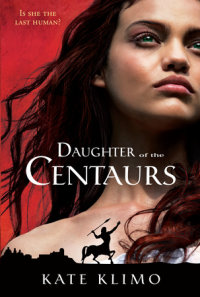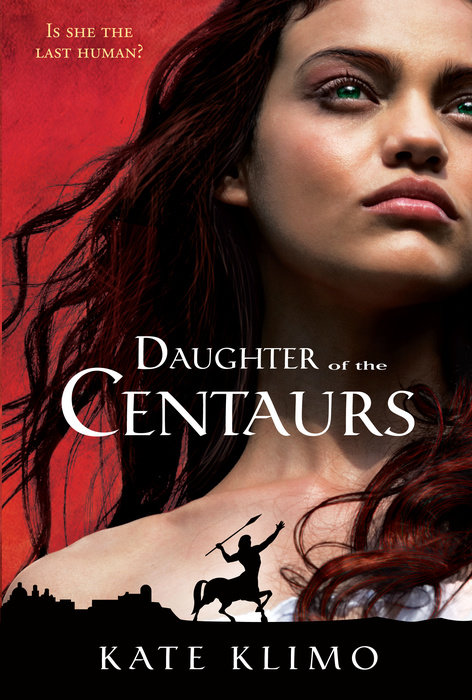Centauriad #1: Daughter of the Centaurs
Centauriad #1: Daughter of the Centaurs is a part of the Centauriad collection.
A new character joins the ranks of pwerful, kick-ass heroines such as those written by Tamora Pierce, Kristin Cashore, Esther Freisner, and Robin McKinley—Malora Ironbound. A great read also for anyone who loves horses and the Greek myths.
Malora knows what she was born to be: a horse wrangler and a hunter, just like her father. But when her people are massacred by batlike monsters called Leatherwings, Malora will need her horse skills just to survive. The last living human, Malora roams the wilderness at the head of a band of magnificent horses, relying only on her own wits, strength, and courage. When she is captured by a group of centaurs and taken to their city, Malora must decide whether the comforts of her new home and family are worth the parts of herself she must sacrifice to keep them.
Kate Klimo has masterfully created a new world, which at first seems to be an ancient one or perhaps another world altogether, but is in fact set on earth sometime far in the future.
An Excerpt fromCentauriad #1: Daughter of the Centaurs
CHAPTER 1
Jayke’s Rope
For as long as she can remember, Malora has dreamed of dancing with horses.
“Daughter of the Mountains,” Malora’s mother calls her, for her skin and hair are the dusky red-brown of the rocks, and her upturned eyes—so like her father’s—are the vivid blue-green of the nuggets of malachite that dot the streams running down from the peaks. But when Malora hears her-self so called, she frowns. “No!” she insists. “Not the mountains! I am the Daughter of the Plains.”
For the horses come from the plains.
These are the days when the People occupy the Settlement, a mere one hundred men, women, and children living together in a canyon in the shadow of the mountains that rear up over the plains running to the north. From this canyon, the men ride out on horseback every dawn to hunt, leaving the women to keep the houses and raise the children. Like all the women, Malora’s mother has a secondary job, and hers is healer. She expects her daughter to follow in her footsteps, as she has in those of her own mother, and so on, as far back as any of them can remember, to the time of the Grandparents. Malora is an only child, as well as the sole survivor of a juvenile epidemic that wiped out all the children born within three years of her. Many in the Settlement believe that it was her mother’s skill at healing that saved Malora and, while no one can prove it, her mother’s witchery that killed all the others. Malora knows this to be ridiculous, but it has discouraged her from pursuing the healing arts.
Malora’s father, Jayke, is a master horseman, and what she wants, more than anything, is to ride and hunt as he does, wheeling about and charging off, bow and arrows strapped to her back. As fond and indulgent as he is of Malora, Jayke does his best, without being unkind, to discourage this ambition in her. No one knows better than he how dangerous horses and hunting can be. His broad-shouldered, rangy body, with its white scrawl of scars writ large, its litany of broken bones, and its nearly constant com-plaint of aching joints that only his wife’s herbal liniment can satisfy, is testimony to this fact. Malora likes to point to each scar and get him to tell her the story behind it; the stories, after many tellings, are pared down to a kind of point-and-response game:
“Horse kick.”
“Boar gore.”
“Bull elephant tusk.”
“Rhino charge.”
Malora, a sturdy and independent eleven years old, tags along behind Jayke like a barn cat as he inspects the horses for ticks. “Run along and grind herbs with your mother. Do you want to end up like the Simple One?” he asks her.
The Simple One is Aron, whose horse, spooked by an asp, bucked him when he was a child, cracking his skull like an ostrich egg against a sharp rock. Ever since, Aron has been as simple as a five-year-old, though he has retained enough sense to be an adequate stable boy and an oddly fitting companion to Malora. While their actual age difference is fifteen years, she has outsmarted him since she was three. Yet there are things about horses he can still teach her. Things like: “Never feed a horse at the same time every day, Malora. If the horse knows the food is coming, her stomach will start a-boiling and bubbling, and before long she’s burned a big hole in it. If she doesn’t know when the food is coming, her stomach simmers down and she waits.”
Or: “Never come up on a horse you don’t know when he is at his feed. He’ll think you’re trying to take it away from him, and he might attack you.”
Or: “Never try to catch a horse who is all stirred up. Ignore her for a while and pretty soon she’ll walk right up to you.”
“I wouldn’t mind being like Aron,” Malora says to her father. “He gets to sleep with the horses.”
“What about Stumpy Eld?” Jayke asks. Stumpy Eld lost the tips of the fingers on one hand to the gnashing teeth of an angry stallion.
“He came at the stallion with an open palm,” Malora says. “How many times have you told him never to do that?” And then there is Gar, Jayke’s best friend, whose limp is the result of the lightning-quick kick of a feisty mare.
“Horses kick,” Malora says with a world-weary sigh worthy of Jayke.
“My point exactly! You can never be too careful around horses,” Jayke says, “and no one can be careful all the time.” “I can be at least as careful as you,” Malora says, indicating with her little finger the head of a tick he has missed.
All else having failed, Jayke says, “Look at these brutes,” pointing to the two long rows of bobbing horse heads facing into the stable aisle. As if to illustrate his point, one of them lands a thunderous kick on the side of the stall. “And look at you. How do you expect them to pay you any mind when you’re no bigger than a rabbit?”
Malora has seen rabbits streak across the paddock and send the horses into a tail-whipping tizzy until Jayke goes among them and gentles them with his low, steady voice and his large, rough hands with their blunt-tipped fingers. Only Jayke can enter the paddock when they are riled, because he has made himself one of them. He is, in a manner of speaking, the lead horse. One day, the horses will follow her lead the way they do her father’s. Meanwhile, Malora, side by side with Aron, peers through the slats in the training-pen fence and watches Jayke work.

